Errors and exception
- 2. Errors âĒ Errors are classified into two categories:- Compile-time errors:- All syntax errors will be detected and displayed by the java compiler and therefore these errors are known as compile time errors âĒ Run-time errors :- Run time errors are type of errors which are occurred by dividing an integer by zero, trying to cast an instance of a class to one of its sub class.
- 3. âĒ Error occurred in execution time, Abnormal termination of program, Wrong execution result Provide an exception handling mechanism in language system Improve the reliability of application program that allows simple program code for exeception check and handling into source
- 4. Exception Definition âĒ Treat exception as an object âĒ All exceptions are instances of a class extended from Throwable class or its subclass. âĒ Generally, a programmer makes new exception class to extend the Exception class which is subclass of Throwable class.
- 5. System-Defined Exception âĒ Raised implicitly by system because of illegal execution of program âĒ When cannot continue program execution any more âĒ Created by Java System automatically âĒ Exception extended from Error class and RuntimeException class
- 6. System-Defined Exception âĒ IndexOutOfBoundsException : â When beyond the bound of index in the object which use index, such as array, string, and vector âĒ ArrayStoreException : â When assign object of incorrect type to element of array âĒ NegativeArraySizeException : â When using a negative size of array âĒ NullPointerException : â When refer to object as a null pointer âĒ SecurityException : â When violate security. Caused by security manager âĒ IllegalMonitorStateException : â When the thread which is not owner of monitor involves wait or notify method
- 7. Programmer-Defined Exception Exceptions raised by programmer âĒ Check by compiler whether the exception handler for exception occurred exists or not â If there is no handler, it is error âĒ Sub class of Exception class
- 8. Exception Occurrence âĒ Raised implicitly by system âĒ Raised explicitly by programmer â throw Statement
- 9. Exception Occurrence class ThrowStatement extends Exception { public static void exp(int ptr) { if (ptr == 0) throw new NullPointerException(); } public static void main(String[] args) { int i = 0; ThrowStatement.exp(i); } } class ThrowStatement extends Exception { public static void exp(int ptr) { if (ptr == 0) throw new NullPointerException(); } public static void main(String[] args) { int i = 0; ThrowStatement.exp(i); } } java.lang.NullPointerException at ThrowStatement.exp(ThrowStatement.java:4) at ThrowStatement.main(ThrowStatement.java:8) java.lang.NullPointerException at ThrowStatement.exp(ThrowStatement.java:4) at ThrowStatement.main(ThrowStatement.java:8)
- 10. Exception Occurrence âĒ throws Statement â When programmer-defined exception is raised, if there is no exception handler, need to describe it in the declaration part of method ïĶ [ThrowsClause.java] [modifiers] returntype methodName(params) throws e1, ... ,ek {[modifiers] returntype methodName(params) throws e1, ... ,ek { }
- 11. Exception Handling âĒ try-catch-finally Statement â Check and Handle the Exception ïĶ [ExceptionHandler.java] try { // âĶ } catch (ExceptionType1 identifier) { // âĶ } catch (ExceptionType2 identifier) { // âĶ } finally { // âĶ } try { // âĶ } catch (ExceptionType1 identifier) { // âĶ } catch (ExceptionType2 identifier) { // âĶ } finally { // âĶ }
- 12. Exception Handling âĒ Default Exception Handler â When system-defined exception occurred, if programmer does not deal with it, it would be processed by default exception handler â Simple function to output error message and exit âĒ Execution Order of Exception Handler â Finally clause is executed independent of exception and catch ïĶ [SystemHandler.java] , [FinallyClause.java]

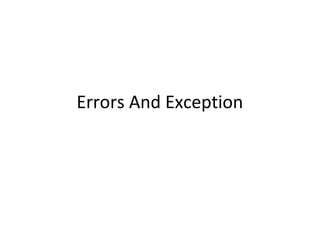
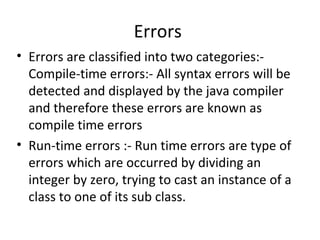

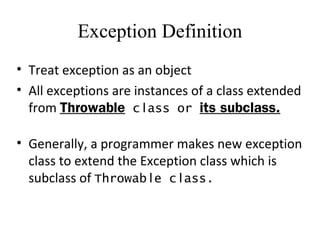
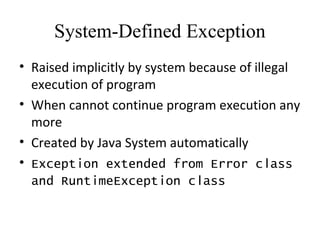
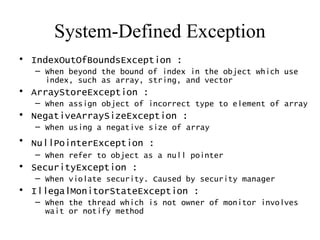


![Exception Occurrence
class ThrowStatement extends Exception {
public static void exp(int ptr) {
if (ptr == 0)
throw new NullPointerException();
}
public static void main(String[] args) {
int i = 0;
ThrowStatement.exp(i);
}
}
class ThrowStatement extends Exception {
public static void exp(int ptr) {
if (ptr == 0)
throw new NullPointerException();
}
public static void main(String[] args) {
int i = 0;
ThrowStatement.exp(i);
}
}
java.lang.NullPointerException
at ThrowStatement.exp(ThrowStatement.java:4)
at ThrowStatement.main(ThrowStatement.java:8)
java.lang.NullPointerException
at ThrowStatement.exp(ThrowStatement.java:4)
at ThrowStatement.main(ThrowStatement.java:8)](https://image.slidesharecdn.com/errorsandexception-150320124253-conversion-gate01/85/Errors-and-exception-9-320.jpg)
![Exception Occurrence
âĒ throws Statement
â When programmer-defined exception is raised, if
there is no exception handler, need to describe it
in the declaration part of method
ïĶ [ThrowsClause.java]
[modifiers] returntype methodName(params) throws e1, ... ,ek {[modifiers] returntype methodName(params) throws e1, ... ,ek { }](https://image.slidesharecdn.com/errorsandexception-150320124253-conversion-gate01/85/Errors-and-exception-10-320.jpg)
![Exception Handling
âĒ try-catch-finally Statement
â Check and Handle the Exception
ïĶ [ExceptionHandler.java]
try {
// âĶ
} catch (ExceptionType1 identifier) {
// âĶ
} catch (ExceptionType2 identifier) {
// âĶ
} finally {
// âĶ
}
try {
// âĶ
} catch (ExceptionType1 identifier) {
// âĶ
} catch (ExceptionType2 identifier) {
// âĶ
} finally {
// âĶ
}](https://image.slidesharecdn.com/errorsandexception-150320124253-conversion-gate01/85/Errors-and-exception-11-320.jpg)
![Exception Handling
âĒ Default Exception Handler
â When system-defined exception occurred, if
programmer does not deal with it, it would be
processed by default exception handler
â Simple function to output error message and exit
âĒ Execution Order of Exception Handler
â Finally clause is executed independent of
exception and catch
ïĶ [SystemHandler.java] ,
[FinallyClause.java]](https://image.slidesharecdn.com/errorsandexception-150320124253-conversion-gate01/85/Errors-and-exception-12-320.jpg)